The "FUKUOKA Method,"
striving as a relief to save the world from solid waste management problems
2019.10.01
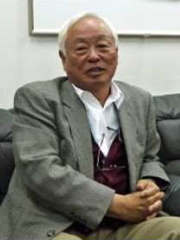
"Semi-Aerobic Landfill Concept," now commonly known idea to the world: Prof. MATSUFUJI Yasushi, Ph., D. Eng.,Professor Emeritus, Fukuoka University
"People: a story for tomorrow" this time covers Dr. MATSUFUJI Yasushi, Professor Emeritus, Fukuoka University, who has kindly provided instructions on the "FUKUOKA Method," a series of landfill disposal technology for solid waste to JICA training participants for a long time.
Prof. Matsufuji was dispatched to Malaysia as a JICA long-term expert from 1988 to 1990 for transfer of landfill disposal technology, and thereafter from 1991 up to date, has accepted about 100 participants of 50 countries every year from JICA Centers all over Japan in Fukuoka University, to disseminate the FUKUOKA Method. Please find his story below.
Prof: "FUKUOKA Method" is a semi-aerobic landfill disposal technology for solid waste. Under an anaerobic condition in a landfill, the method creates conditions in which air is easily introduced to the bottom of the landfill layer, and secures ease of respiration through installation of pipes for quick drainage of contaminated water. There, air is not mechanically introduced at a time by force, but rather through agitation of convection current. Heat by fermentation of microorganisms can be utilized to generate convection current within a landfill, which is comparable to an uprising current of heated water from the bottom of bath tab to the upper part. In this way, fresh air is introduced to the bottom part of landfill from outside.
Just as capillary vessels deliver oxygen to the very end of human body, it is better if air is introduced to every single corner of a landfill site. Because of that, pipes are supposed to be densely installed within a landfill to introduce air. By doing so, decomposition of waste is accelerated and concentration of contaminants in the leachate water is also reduced.
Creation of an aerobic condition brings less generation of methane gas, which further contributes to tackle global warming.
Quick stabilization of a landfill via FUKUOKA Method also means capability of quick utilization of post-service landfill, which again brings ease of such utilization.
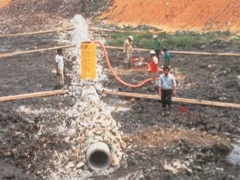
A semi-aerobic landfill site, using bamboo and waste oil drum
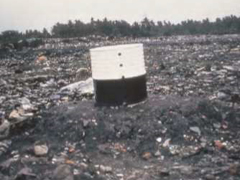
A gas vent using waste oil drum
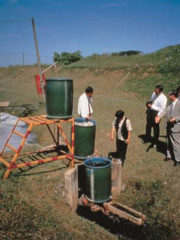
Leachate water treatment equipment (a pilot plant)
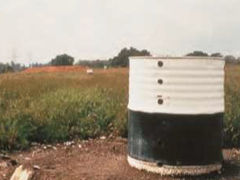
Recovery of vegetation through effect of gas vent
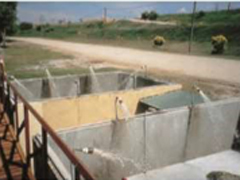
Adsorption using waste activated carbon
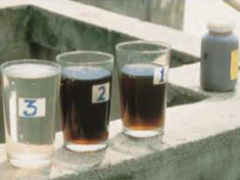
Leachate water (1: raw 2: after aeration 3: after filtration / adsorption)
In terms of materials to be used for FUKUOKA Method, there is no particular limitation to be specific. Any "locally available materials," although they might not perfect, would work to certain extent.
Therefore, in any developing countries natural stones, for example, might not be available, for which construction / demolition waste, bricks could be alternatives to replace them. In an island, we even used broken containers of beer bottles for this purpose.
In my opinion, tolerance, or margin to allow use of "locally available materials" is a good drive for people in developing countries to move just one step forward for an improvement of their landfill disposal sites.
Prof: Fundamentals of "FUKUOKA Method" remain unchanged, but climatic conditions such as rainfall amount and temperature, as well as geological conditions and concentration of oxygen are influential. Bhutan and Mexico, for example, are not rich in oxygen due to their high elevation. The number of microorganisms in such countries is smaller, although the difference is not quite much, compared with countries at lower elevation. Therefore the design of the landfill site should be modified to some extent.
Countries like Afghanistan, in which rainfall is very much limited, and rainforest, in which annual rainfall is as much as 3,000mm, are not actually comparable in terms of the scale of the regulating pond to store rainwater, which accordingly should be modified. Because of that, we carry out experimental studies in about 14 different countries of different environmental conditions to work with technical transfer of "FUKUOKA Method" to be locally acceptable in a global scale.
In an international conference, "International Conference on Solid Waste Management" that was held in early October-2017, I was awarded with a special prize for "long-time and world-wide dissemination of semi-aerobic landfill concept." At that time, the secretariat of the conference officially stated the terminology of "semi-aerobic landfill concept" in English. Actually, this "semi-aerobic" is a coined English word, or a Japanese-made English word. Rather because of that, our "FUKUOKA Method" has not been officially acknowledged by the society for a long time due to the fact that no proper naming was given especially in English-speaking world to say about it, and the coined word explained only about the word itself. I believe it is quite remarkable to find this Japan-made English "Semi-aerobic Landfill Concept" to be acceptable even among professionals. I proposed the concept back in 1975, and it took as long as 42 years, almost half a century to come all this way.
Prof: I was dispatched to Malaysia from 1988 to 1990 for transfer of landfill disposal technologies.
Prior to myself, Prof. SAKURAI Kunitoshi, former President of Okinawa University,
was dispatched as my predecessor to be a JICA Expert to draft the first full-scale Master Plan on solid waste management in Malaysia by the name of "ABC plan," in which he proposed 12 action plans for improvement of solid waste management field. The most important topic in that plan was technical transfer of "sanitary landfill disposal," then I came into the position to succeed the position of Prof. Sakurai.
The "FUKUOKA Method" already was a proved technique for more than 20 years at that time, therefore it was already authorized among professionals in Japan. On the other hand, I honestly have had a notion to wonder whether or not the method is very really applicable to overseas in which culture and climatic conditions are different. When the method was put into practice, however, the result was comparatively good.

At that time, landfill sites in Malaysia were close to the situations of the landfill site in Hatta Area located in eastern part of Fukuoka City, which was a field survey site back in 1971, when I started my research on waste, so I thought as if I were back to that time. Because of that, in Malaysia as well, I worked with improvement of landfill disposal site through a step- by-step approach, utilizing things I had learned through practical experiences in landfill sites of Fukuoka at the very beginning of my carrier.
Saying "improvement of landfill disposal sites in developing countries" is easy, but the reality that I saw by that time was an inferno covering considerable portion of a landfill site caused by landfill gas generated from waste. Also, a new site for landfill disposal at that time was selected through theoretical site selection method, but it ended up with a failure to return to conventional status soon upon return of JICA Experts back to Japan. What I talked with Prof. Sakurai then was to follow a three-stepwise approach, starting with an improvement of an existing landfill disposal site, followed by technical transfer of "FUKUOKA Method" when the impact of the improvement was to some extent significant, and eventually to work with leachate water treatment. This really was a challenge not to address to the problem in full scale from the beginning, but to proceed to the next steps on one-by-one basis.
I talk in my lecture on technical advancement in Japan in the last 50 years. Japan indeed has not accomplished all that we have just overnight, but has come through many failures, and only through such failures, we came up with knowledge and experiences for solutions new to us at that time. That is the point which has to be conveyed thoroughly for a successful technical transfer unless otherwise it ends up with a failure, and I have learned
this spirit to the core when I was young. The secret behind the success of technical transfer in Malaysia, I believe, could be a practice recalling such memories.
Prof: Our success in Malaysia has drawn growing attention both in Japan and overseas. Since 1991, a year after my return from Malaysia, acceptance of JICA training participants has started, which made Fukuoka University as a center of all JICA Centers in Japan to transfer waste landfill disposal technology, and about 100 participants from 50 countries visit and learn "FUKUOKA Method" every year. Lecture notes as well were developed through revisions. I believe the scope of participants has already covered most Asian countries subject to ODA, but nowadays we accept more participants from Middle and South American, and in particular from African Countries.
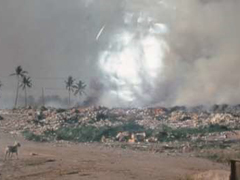
Ampang Jajal L/F (Malaysia) before improvement (1988)
As I told before, "FUKUOKA Method" can be carried out by using "locally available materials." Reflecting that, the other day I heard a participant say "Conventionally I had a mindset that improvement of a landfill disposal site cannot be done without budgetary resources, but I recognized "FUKUOKA Method" is applicable by using materials available in my own country."
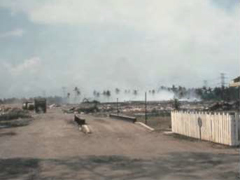
The site in the process of improvement
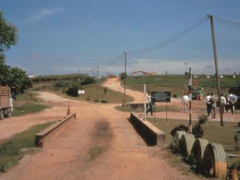
Ampang Jajal L/F after improvement (1996)
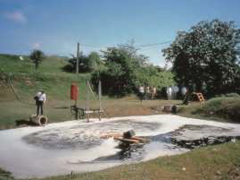
aeration using a multi-purpose oxidation pond (lagoon)
It would be nice if we find as many participants as possible, upon their return to their home countries after learning in Japan, with his/her hope that "this might be applicable, and worth doing in my country" to re-start his/her carrier as an expert on solid waste management in a dedicated manner.
As for myself, waste management indeed was not my academic specialty, which originally was pharmaceutical sciences, but I do not regret at all after 50 years. In the beginning of my carrier, however, people around me were not always friendly to me, asking me "why do you work on research in waste after getting university degree?" Back in their own countries, participants, too, may come up with the same idea. If we find a participant, even one participant, holding a philosophy in his/her mind that "this is an important challenge, and nobody else, but myself could be the last chance to address solid waste management problems in my country," then I would say that JICA training programs are successful.
Prof: Upon my mandatory retirement from Fukuoka University in March 2018, my present dream for the future is to challenge for limitations of "FUKUOKA Method."
Any technology has its own limitations. More substantially, I believe there might be the cases for which "FUKUOKA Method" is not applicable. For example, due to the fact that the core of the method is microbial fermentation, at this moment I believe it is not applicable in places that cannot provide good environment for microorganisms. Other than that, it has a precondition that it should create aerobic conditions, and due to that, the method is difficult to apply in places with poor oxygen supply.
In my idea, clarifying the limitation of the "FUKUOKA Method," a Japan-made technology originated in Fukuoka, Japan, is indispensable for the method to be a truly scientific method. An automobile is a very complicated machinery, but everyone can use it. In case of landfill disposable technology, however, it is not so well systematized to this far yet.
Our challenge should keep going, in that the method is still in a development stage, until we come to the point that this method is applicable in places with poor budgetary resources, with low literacy rate, etc.
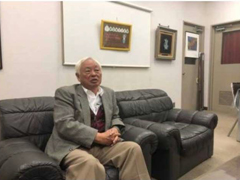
I believe this field would never find the goal after long involvement into it, and I also hope young researchers and engineers to follow my path and succeed. My present hope, anyway, is to work with the project that I am committed now, as much as possible to step forward.
scroll